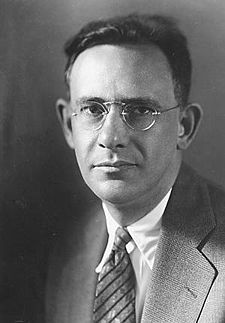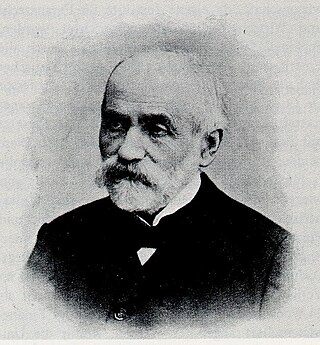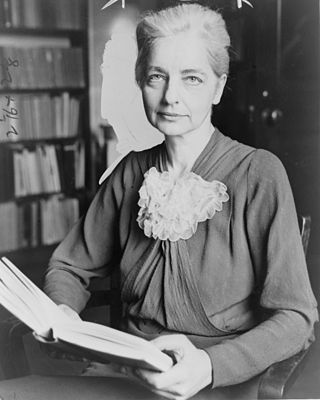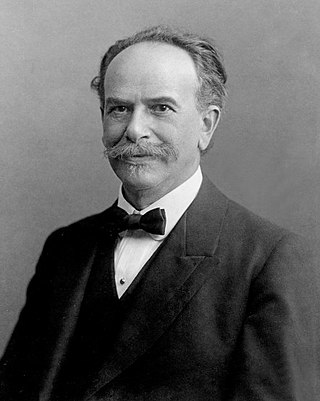
Cultural anthropology is a branch of anthropology focused on the study of cultural variation among humans. It is in contrast to social anthropology, which perceives cultural variation as a subset of a posited anthropological constant. The term sociocultural anthropology includes both cultural and social anthropology traditions.

Edward Sapir was an American anthropologist-linguist, who is widely considered to be one of the most important figures in the development of the discipline of linguistics in the United States.

Ethnocentrism in social science and anthropology—as well as in colloquial English discourse—means to apply one's own culture or ethnicity as a frame of reference to judge other cultures, practices, behaviors, beliefs, and people, instead of using the standards of the particular culture involved. Since this judgment is often negative, some people also use the term to refer to the belief that one's culture is superior to, or more correct or normal than, all others—especially regarding the distinctions that define each ethnicity's cultural identity, such as language, behavior, customs, and religion. In common usage, it can also simply mean any culturally biased judgment. For example, ethnocentrism can be seen in the common portrayals of the Global South and the Global North.

Margaret Mead was an American cultural anthropologist who featured frequently as an author and speaker in the mass media during the 1960s and the 1970s.

Ruth Fulton Benedict was an American anthropologist and folklorist.
In anthropology, folkloristics, and the social and behavioral sciences, emic and etic refer to two kinds of field research done and viewpoints obtained.

Boasian anthropology was a school within American anthropology founded by Franz Boas in the late 19th century.

The Chrysanthemum and the Sword: Patterns of Japanese Culture is a 1946 study of Japan by American anthropologist Ruth Benedict compiled from her analyses of Japanese culture during World War II for the U.S. Office of War Information. Her analyses were requested in order to understand and predict the behavior of the Japanese during the war by reference to a series of contradictions in traditional culture. The book was influential in shaping American ideas about Japanese culture during the occupation of Japan, and popularized the distinction between guilt cultures and shame cultures.
Rhoda Bubendy Métraux was a prominent anthropologist in the area of cross-cultural studies. She collaborated with Alfred Métraux on mutual studies of Haitian voodoo. She also studied the Iatmul people of the middle Sepik River in Papua New Guinea and made three fieldwork trips to Tambunum village of 6-7 months each in 1967-1968, 1971, and 1972-1973 that focused on music. During one of her studies, Métraux administered the Lowenfeld Mosaic Test in Tambunum, developed by a Margaret Lowenfeld. Additionally, Métraux did fieldwork in Mexico, Argentina, and Montserrat in the West Indies and enrolled at Yale University to study for her doctorate under the tutelage of Bronisław Malinowski. During World War II, Métraux headed the section on German morale for the US Office of Strategic Services (OSS).
Feminist anthropology is a four-field approach to anthropology that seeks to transform research findings, anthropological hiring practices, and the scholarly production of knowledge, using insights from feminist theory. Simultaneously, feminist anthropology challenges essentialist feminist theories developed in Europe and America. While feminists practiced cultural anthropology since its inception, it was not until the 1970s that feminist anthropology was formally recognized as a subdiscipline of anthropology. Since then, it has developed its own subsection of the American Anthropological Association – the Association for Feminist Anthropology – and its own publication, Feminist Anthropology. Their former journal Voices is now defunct.
Psychological anthropology is an interdisciplinary subfield of anthropology that studies the interaction of cultural and mental processes. This subfield tends to focus on ways in which humans' development and enculturation within a particular cultural group—with its own history, language, practices, and conceptual categories—shape processes of human cognition, emotion, perception, motivation, and mental health. It also examines how the understanding of cognition, emotion, motivation, and similar psychological processes inform or constrain our models of cultural and social processes. Each school within psychological anthropology has its own approach.
Clinical ethnography is a term first used by Gilbert Herdt and Robert Stoller in a series of papers in the 1980s. As Herdt defines it, clinical ethnography
is the intensive study of subjectivity in cultural context...clinical ethnography is focused on the microscopic understanding of sexual subjectivity and individual differences within cross-cultural communities. What distinguishes clinical ethnography from anthropological ethnography in general is (a) the application of disciplined clinical training to ethnographic problems and (b) developmental concern with desires and meanings as they are distributed culturally within groups and across the course of life.

Cora Alice Du Bois was an American cultural anthropologist and a key figure in culture and personality studies and in psychological anthropology more generally. She was Samuel Zemurray Jr. and Doris Zemurray Stone-Radcliffe Professor at Radcliffe College from 1954. After retirement from Radcliffe, she was Professor-at-large at Cornell University (1971–1976) and for one term at the University of California, San Diego (1976).

American anthropology has culture as its central and unifying concept. This most commonly refers to the universal human capacity to classify and encode human experiences symbolically, and to communicate symbolically encoded experiences socially. American anthropology is organized into four fields, each of which plays an important role in research on culture:
- biological anthropology
- linguistic anthropology
- cultural anthropology
- archaeology
Ruth Leah Bunzel was an American anthropologist, known for studying creativity and art among the Zuni people (A:Shiwi), researching the Mayas in Guatemala, and conducting a comparative study of alcoholism in Guatemala and Mexico. Bunzel was the first American anthropologist to conduct substantial research in Guatemala. Her doctoral dissertation, The Pueblo Potter (1929) was a study of the creative process of art in anthropology and Bunzel was one of the first anthropologists to study the creative process.

Gitel (Gertrude) Poznanski Steed was an American cultural anthropologist known for her research in India 1950–52 involving ethnological work in three villages to study the complex detail of their social structure. She supplemented her research with thousands of ethnological photographs of the individuals and groups studied, the quality of which was recognised by Edward Steichen. She experienced chronic illnesses after her return from the field, but nevertheless completed publications and many lectures but did not survive to finish a book The Human Career in Village India which was to integrate and unify her many-sided studies of human character formation in the cultural/historical context of India.
Vera Dourmashkin Rubin was an anthropologist and the director of the Research Institute for the Study of Man. She specialised in the anthropology of the Caribbean.
Francis L. K. Hsu was a China-born American anthropologist, one of the founders of psychological anthropology. He was president of the American Anthropological Association from 1977 to 1978.
May Mandelbaum Edel was an American anthropologist known for her fieldwork among the Okanagan in Washington, the Tillamook in Oregon, and the Kiga in Uganda. Edel's linguistic research of the Tillamook serves as the only published account of the language which provided data for future linguistic publications. Edel was the first American woman anthropologist to live in an African village, and her research in Africa documented the diversity of African cultures.
Anthropology is the study of human societal and cultural development in the past, present, and future with a number of facets that are categorized into five different fields. These fields include: biological (physical) anthropology, cultural (socio-cultural) anthropology, linguistic anthropology (linguistics), archaeology, and applied anthropology. Applied anthropology is the analysis of human interaction with the purpose of solving practical problems that affect and arise throughout time between cultures and societies. Applied anthropologists use many different methods to conduct research on agriculture, health and medicine, housing, social services, political-economic development, displacement and resettlement, business and industry, education, nutrition, environment, and aging. Applied anthropology research methods are: policy research, evaluation research, cultural intervention, activist (action) research, participatory action research (PAR).









